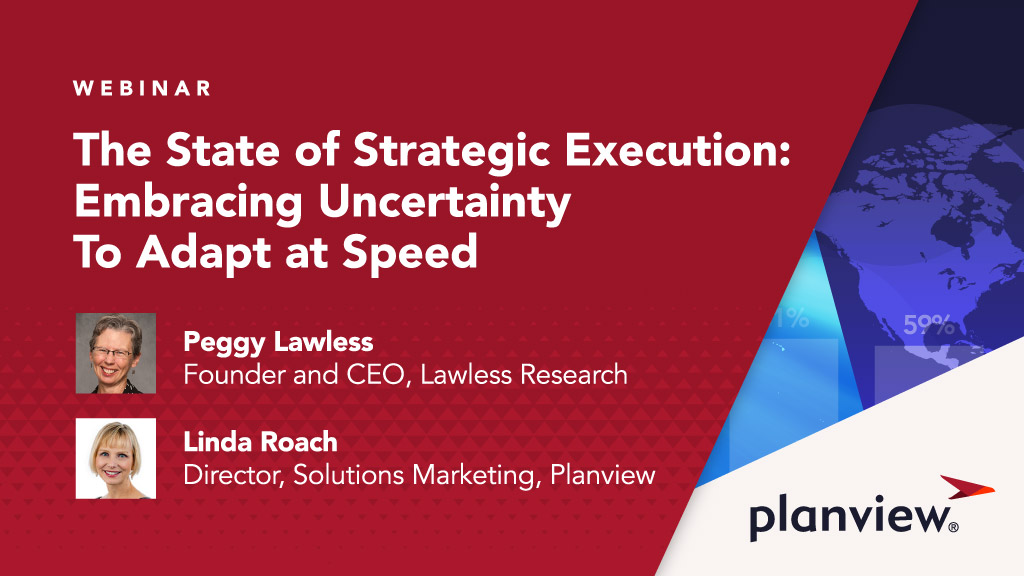
Uncertainty in business is increasing, caused by rapid change, disruptions, unknowns, and whatnots. The problem is treating uncertainty today as an anomaly – a one-off event to overcome – instead of a constant. This is the topic I covered in a recent webinar featuring guest speaker Peggy Lawless, Founder and CEO of Lawless Research.
We jointly presented findings from the new Strategy Execution Benchmark research. Planview partnered with Lawless Research to survey nearly 1,000 business and IT professionals about how fast and how well their organizations react to uncertainty and change, with enlightening results.
Peggy and I received some great questions from the webinar attendees about how to cultivate more speed and agility. Here are our answers along with three insights from the research.

Who Is Overcoming Uncertainty in Business – and How?
For some context, the benchmark survey asked about speed and quality of outcomes across five interconnected steps that organizations must work through in response to change:
- Pivot strategies and plans
- Reallocate funding and budgets
- Reprioritize work execution and delivery
- Realign people and teams
- Access and analyze data for decision making
A category of “Strategy Execution Leaders” emerged from the results. These are organizations that adapt quicker to change and achieve the highest quality outcomes. They’ve begun to master the five competencies of responding to change.
In addition, Leaders have five behaviors and best practices in common. Peggy and I detail each of these best practices in the Webinar. We also discuss how Leaders use them to adapt to change and uncertainty in business and outperform their peers. But how do you begin the transition?

Webinar Q&A: Practical Tips
After hearing about these five practices and other research findings during the webinar, the attendees asked several interesting questions. Here are our answers to four of them concerning how to transition to agile practices:
Q: Can you share some thoughts on how we can better inform our executives and teams what work and initiatives to prioritize?
A: Reprioritization is a core component of responding to change. Let’s say your strategies have changed or another strategy has emerged in response to a market shift – maybe a competitor launched a new product. You first need to look at what you’re currently working on and how well that aligns to the new strategic priorities.
Then have the discussions to determine how you shift. What new work, opportunities, and ideas do you prioritize to meet that new strategic objective? What are your different options for realigning the organization?
Q: We have been trying to do agile for a while… it’s not sticking outside of engineering. What can we do to get more agility in our practices?
A: Look for those opportunities where you’ve got engineering projects or initiatives that have touch-points into other areas of the organization. Pull these other groups into the process so they can see the benefits of working in a more agile type of way. Also, use every opportunity to show the progress you have achieved in engineering that advance the goals of the company.
It’s important for the leadership team to see the benefits of the agile practices, especially to manage uncertainty in business. When you’re bringing innovation or new ideas into the marketplace, the path is not always clear. Agile facilitates the trial-and-error approach required to quickly evolve and grow a capability or a solution, involving customers along the way.

Q: In your experience, what are the challenges companies have faced when bridging the gap between project management and Agile practices?
A: Each has its own purpose, depending on what outcome you’re looking to achieve. The benefit of using both is the ability to define the best way to reach an outcome and execute on it. A lot of our organizations and customers have a mix of traditional project management methodologies, more collaborative approaches, and agile for some of the outcome delivery.
So, it really is this hybrid world. Bring both projects and agile programs into the portfolio to get the visibility and alignment to achieve your strategic objectives.
Q: What are some capabilities we should look for in software? I’m especially interested in what you said about executive line of sight. I don’t care to look at another spreadsheet, and we are one of those companies using an internal tool (it’s a Frankenstein-dinosaur!).
A: I love that phrase! You are not alone. Most of our survey respondents, including the Leaders, are using mainly homegrown solutions or office productivity tools to manage major business processes.
It’s difficult to manage uncertainty in business and adapt at speed using these types of tools. It’s painful to try to obtain the right data – and you cannot gain a clear picture of your strategy-to-delivery process and status, including interdependencies.
This is an opportunity to show the art of the possible to executives. What if they could view the linkages between strategies, outcome, work, financials, and resources? What if they could run what-if scenarios and model possible impacts, such as moving a team to newly prioritized work?
This kind of visibility strengthens decision-making and increases confidence in driving alignment and on time delivery. It’s important to look for solutions that bring together that executive line of sight with adaptive portfolio prioritization and funding along with flexible capacity resource planning and execution tools. Keeping these specifics in mind, here are three high-level recommendations we presented during the webinar.
Three Insights for Accelerating Agility and Managing Uncertainty in Business
- Anticipate and plan for inevitable change: Change is now the norm, increasing uncertainty in business. It’s important to build speed and agility into how your organization works on a day-to-day basis.
- Provide “just enough” governance: Governance was cited as a top barrier to responsiveness to change. Governance is important for accountability as well as alignment to strategy and value. However, organizations need to ensure their current governance principles are supporting and not obstructing their people and teams.
- Realize the criticality of data and analytics: Access to timely, accurate data is crucial for organizations, especially during disruption. The complexities and interdependencies of business today require a technology platform that can deliver the right insights.
Will your company embrace uncertainty or brace for the next impact?
“Use the blueprint of these leading companies to guide your next steps in your journey forward and as we like to say at Planview, there’s never been a better time for change to drive speed and agility in your organization.”
Learn more by reading our announcement blog for The State of Strategy Execution Benchmark Report: Adaptability in Business: Accelerating Strategy Execution During Changing Times.




